-
Car Reviews
- Car News
-
Car Comparisons
Latest comparisons
- Chasing Deals
A British diesel six-powered dual-cab newcomer arrives to take on Toyota Land Cruiser 70 Series and Land Rover’s best
It’s part of automotive folklore now that British billionaire Sir Jim Ratcliffe went and built his own 4WD wagon after Land Rover snubbed his approach to continue building classic Defenders.
We’re not sure if he also asked Toyota if he could assemble the now-axed V8 versions of the Land Cruiser 70, but his Ineos company has gone and built a dual-cab ute with torquey turbo six-cylinder engines regardless.
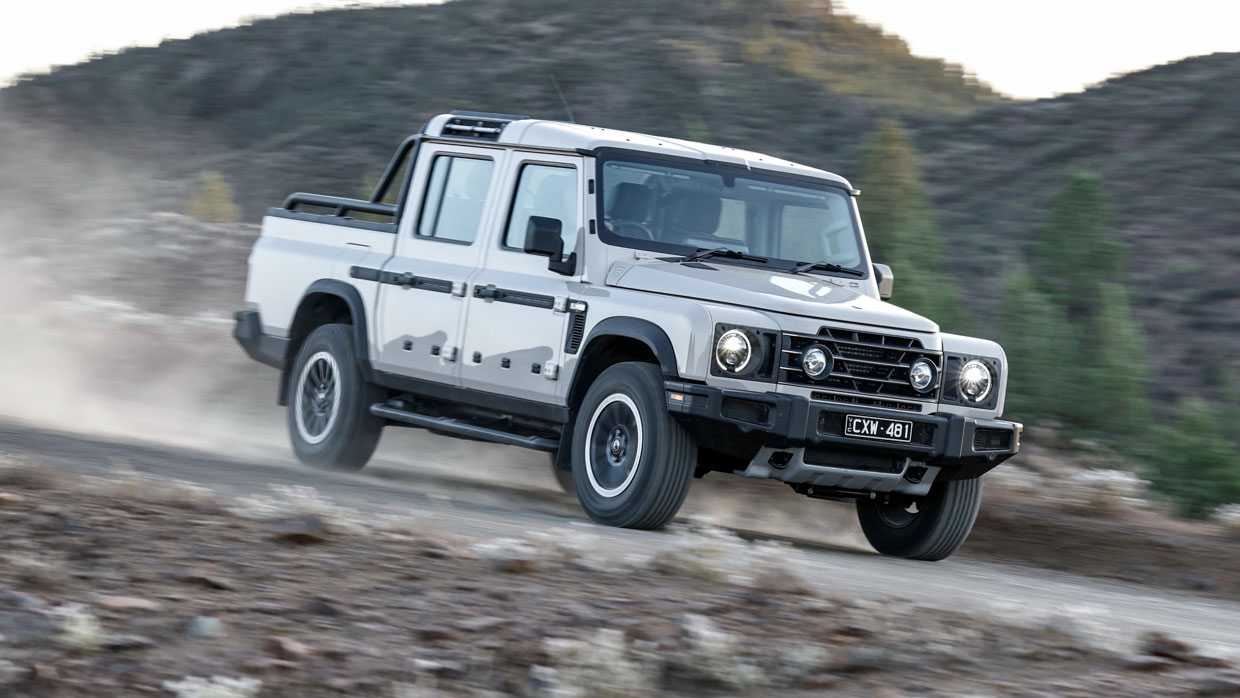
The Grenadier Quartermaster takes half its name from the Grenadier wagon that was released in 2023, and it takes half the bodywork.
It’s identical up to the B-pillar before the ute adds more than half a metre in length via a 30.5cm-longer wheelbase and a much longer rear overhang that help accommodate the tub. The ute’s rear door design is different to the wagon’s as it didn’t need to be shaped around the rear wheelarch.
There are two body styles – a cab-chassis version that is the most direct rival to the LC70, and the tub model that’s closer in concept to a Jeep Gladiator as well as popular dual-cabs such as the Ford Ranger and Toyota HiLux.
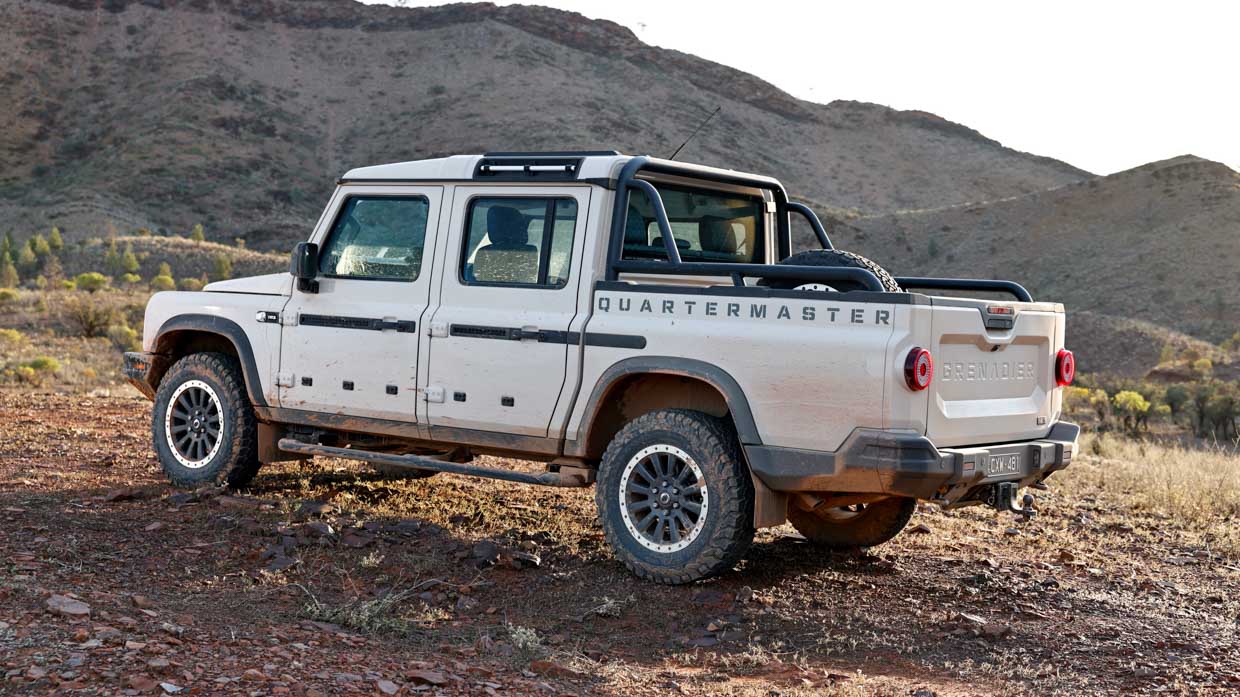
Although the Quartermaster is a competitor to big-selling Ranger and Hilux nameplates in terms of body style, it’s less so by price.
Costing from $102,000 in cab-chassis form or from $105,000 in integrated-tub form before on-road costs (and inevitable option-box ticks), the Quartermaster is priced more like the larger, bigger-towing full-size American pick-ups such as the Ford F-150 and Ram 1500.
Jeep’s Wrangler-based Gladiator costs between about $78,000 and $87,000; the LC70 cab-chassis from about $84,000 before on-roads and tray options.
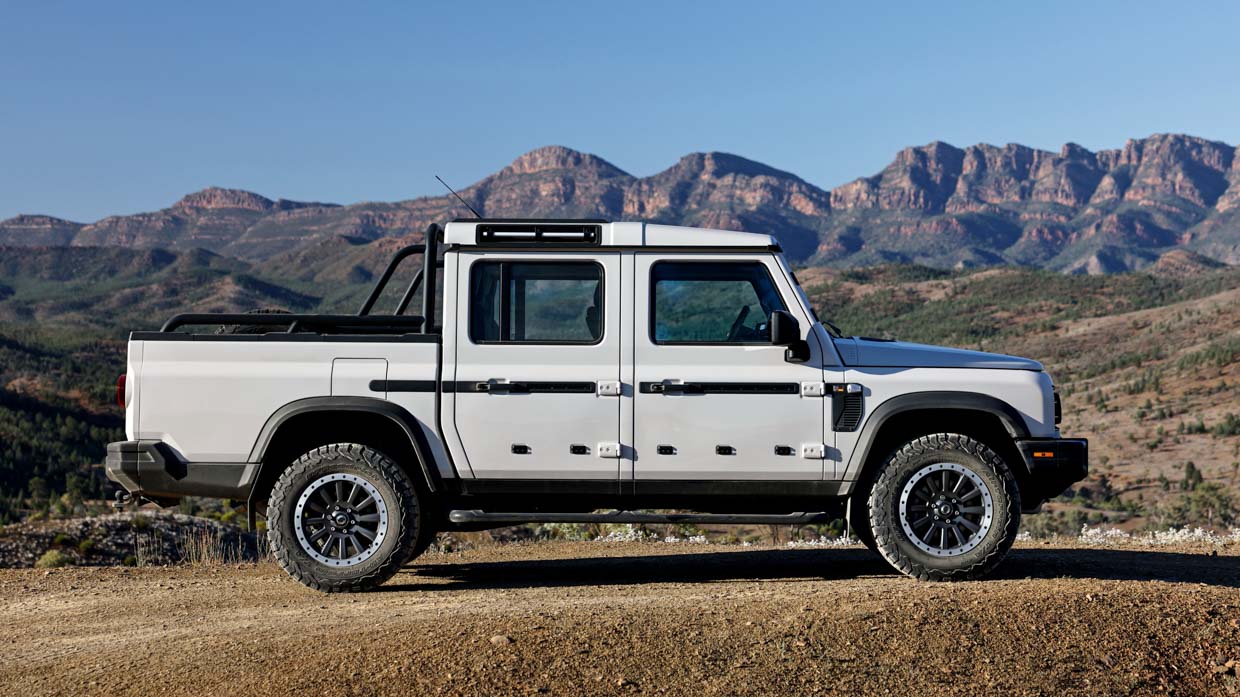
Opt for a luxury-focused Fieldmaster or more off-road-focused Trialmaster grades, the starting point is $118,000 in both cases.
The Quartermaster’s underpinnings and drivetrains are familiar from the Grenadier wagon: a basic but robust body-on-frame foundation, live axles, and coil springs at the rear – against segment norm, like the Gladiator – not just the front.
There’s a choice of BMW petrol or diesel six-cylinder engine, delivering power to permanently driven four wheels via an eight-speed ZF gearbox plus a dual-range transfer case.
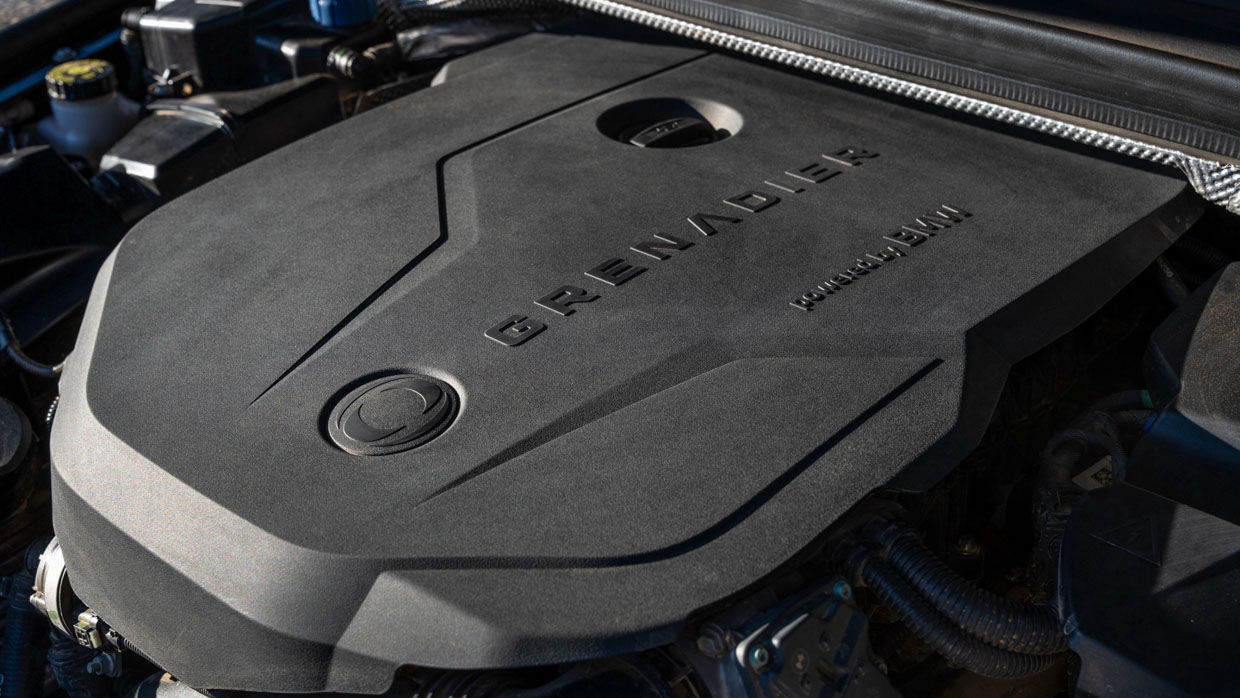
Although a couple of cab-chassis Quartermasters were present on the launch in South Adelaide’s Flinders Ranges, they were reserved for support roles to keep us focused on the integrated-tub model.
Cross bars are standard, though an extensive accessories list includes a lockable roller tonneau cover, waterproof canvas canopy, and a hardtop option is also coming.
Ineos says the tub is big enough to swallow a 1200x800mm Euro pallet, aided by a 1280mm-wide tailgate.
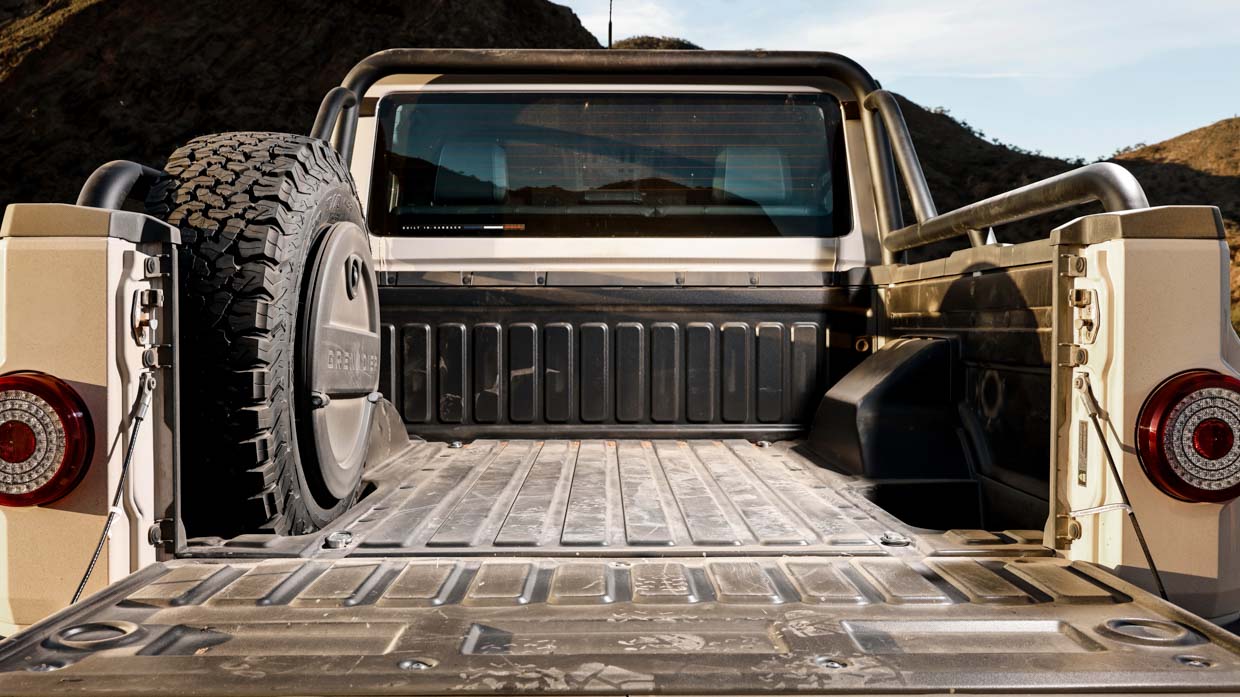
The tailgate lacks damping for soft opening – as you get on some cheaper dual-cabs – though is strong enough to handle up to 225kg, so you and a couple of mates could sit on while enjoying a beer and a panoramic vista!
Payloads vary between drivetrains, with only 832kg for the twin-turbo diesel model that Ineos says will outsell the 907kg-rated single-turbo petrol by four to one.
Although that’s higher than the Gladiator’s lowly 693kg payload, it’s well short of the 1150-1350kg range offered by the leaf-sprung LC70.
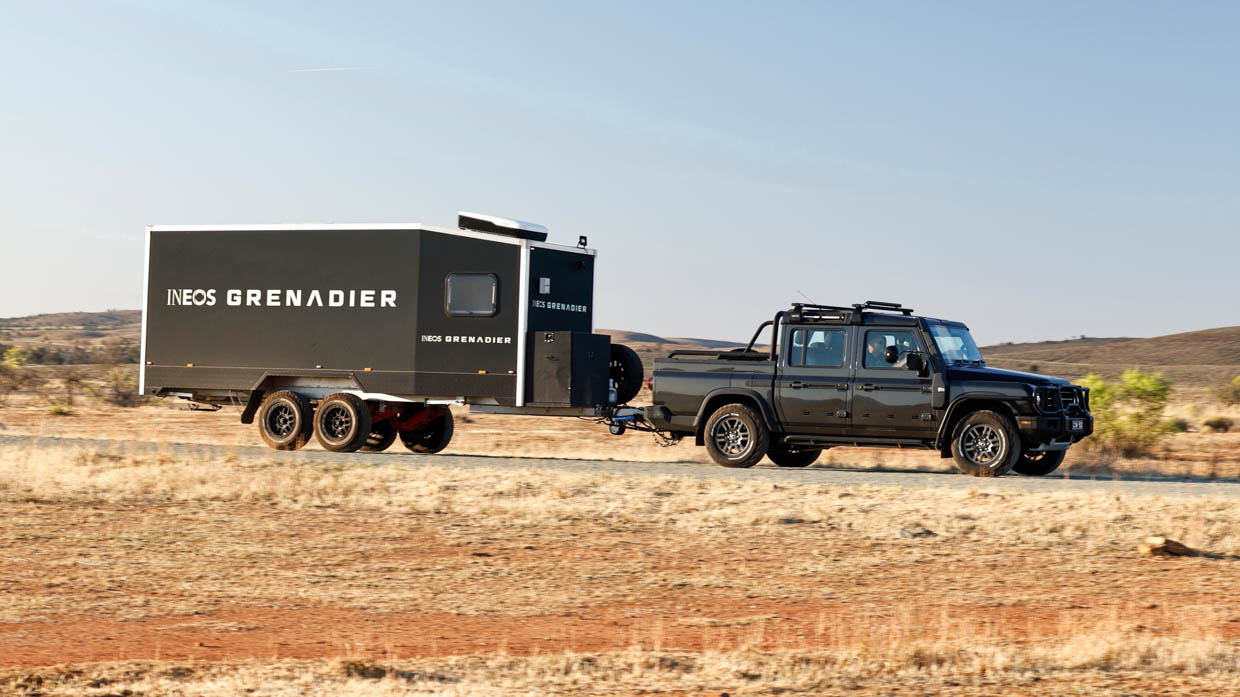
A braked towing capacity of 3.5 tonnes matches the LC70, though, and also betters the 2721kg of the Gladiator.
As with the wagon, the front cabin layout’s overhead and upright consoles – covered in a plethora of switches and toggles – could trick you into thinking you were piloting an A320 rather than an off-road vehicle.
Prewired auxiliary switches are also present on the overhead console to make it simpler to add aftermarket mods such as lighting bars.
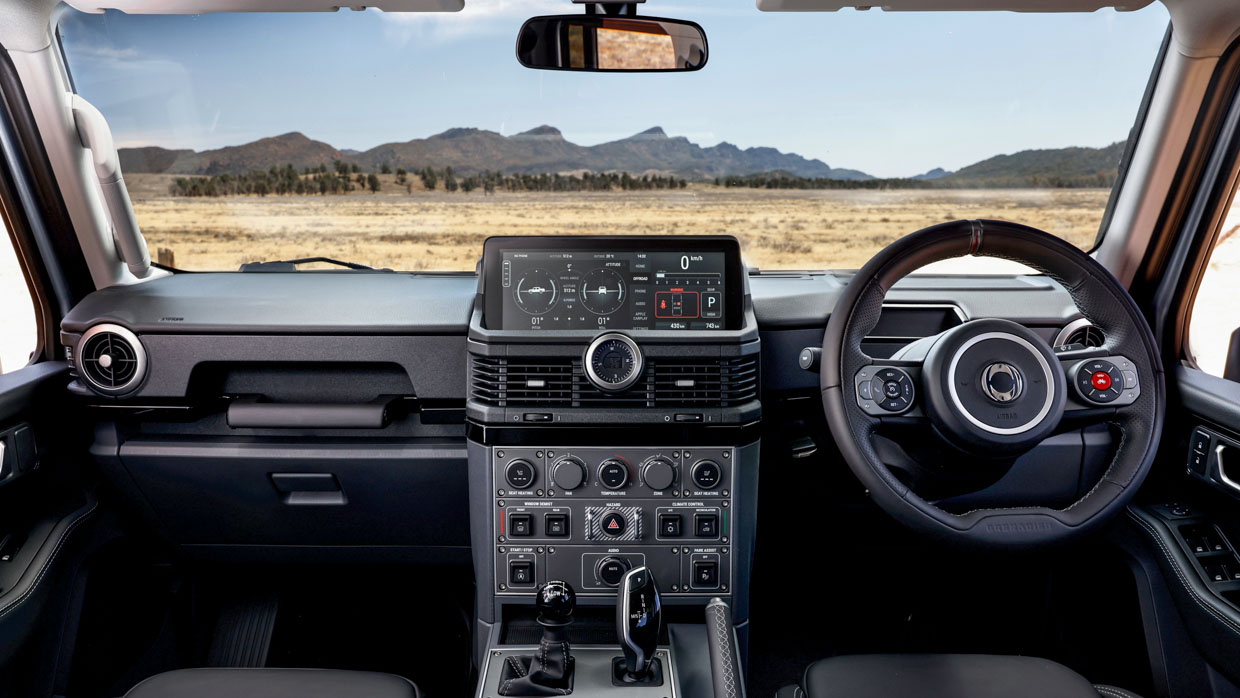
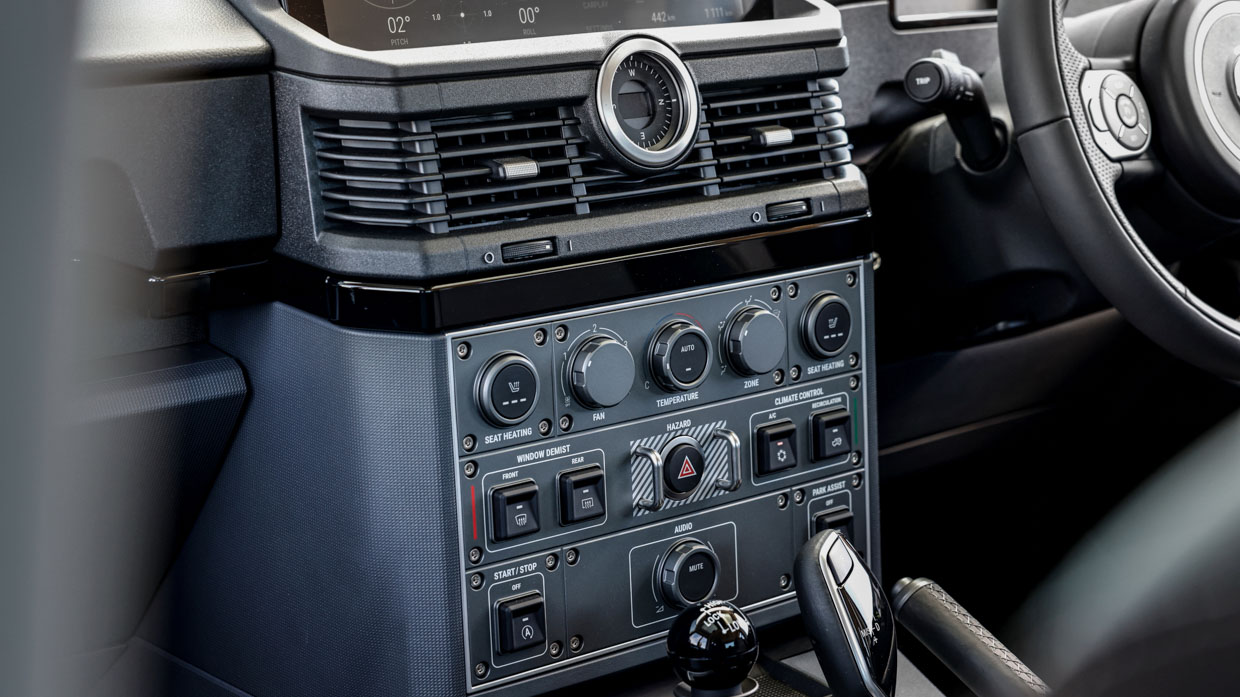
If the Grenadier wagon set out to essentially imitate the old Defender, it wasn’t just its tough-as-nails construction and off-roading capability that it tried mirroring. There are also some cabin quirks that compromise the daily drive … or even long drives, and the Quartermaster is no different.
The biggest offender is a left footrest that is almost non-existent, with the Ineos’s gearbox encroaching on footwell space. An Ineos engineer admitted, commendably, it was an oversight missed during prototype testing, where most mules were left-hand-drivers.
This is somewhat ironic considering Ineos is a British company and the Grenadier models are something of a multinational product – co-developed by Austrian manufacturing specialist Magna Steyr and Ineos’s German-based engineering team, and built in France at a plant previously used by Daimler to build Smart cars.
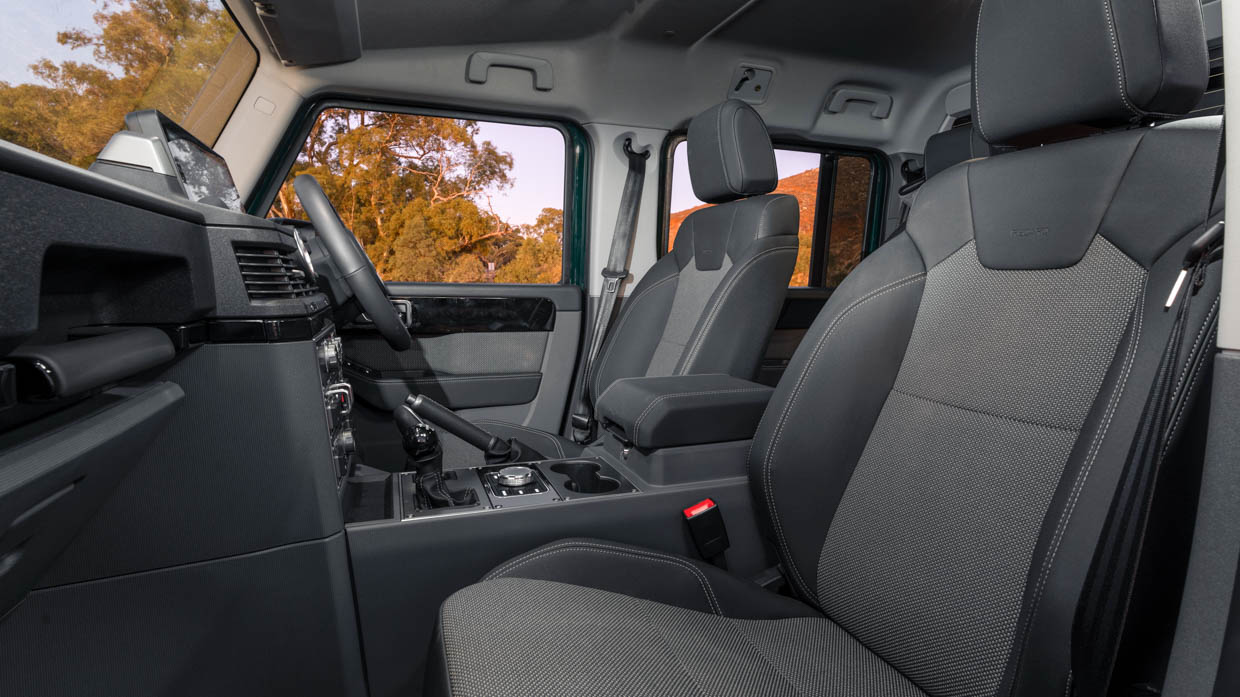
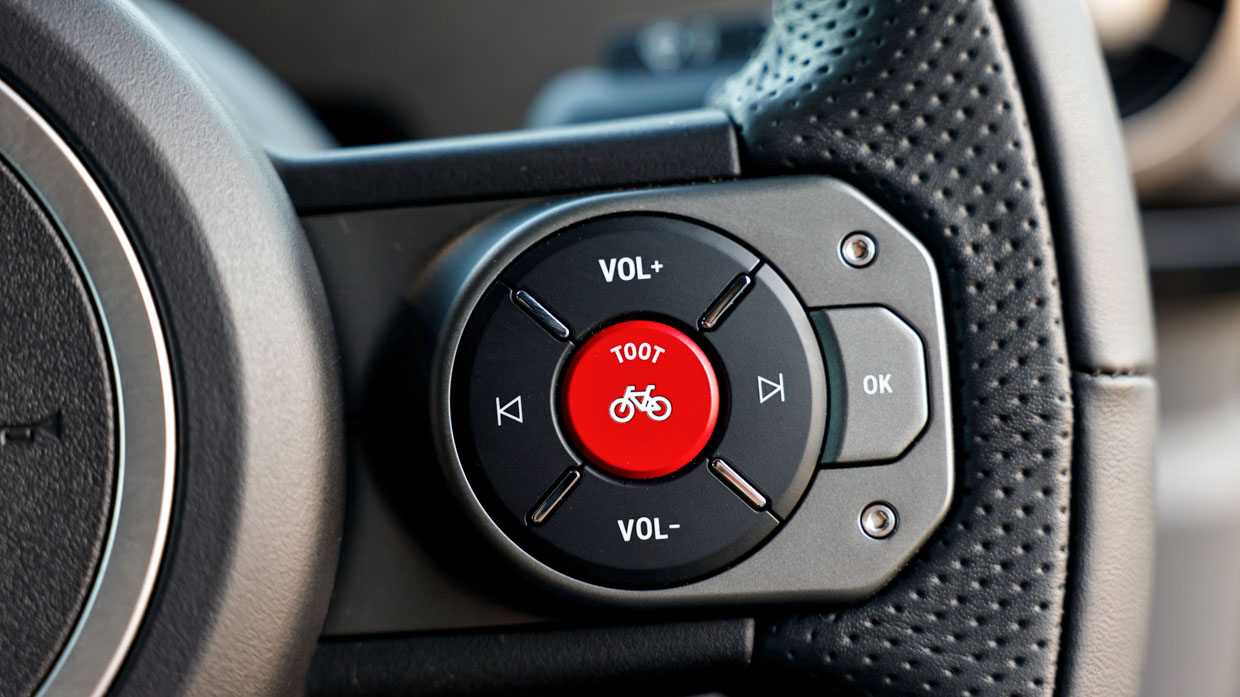
The windows lower with one-touch operation but the button has to be held to close them again.
Ineos copies Tesla by placing driving functions and information – including the speedo – in the central digital touchscreen, but the display is prone to glare in bright weather. There’s no head-up display and instead ahead of the driver is a panel that illuminates symbols for various functions, including exterior lights and diff locks.
While there’s nothing wrong with the functional design of the dash, dominated by the bluff centre console, the quality of plastics is surprisingly low grade for a six-figure ute.
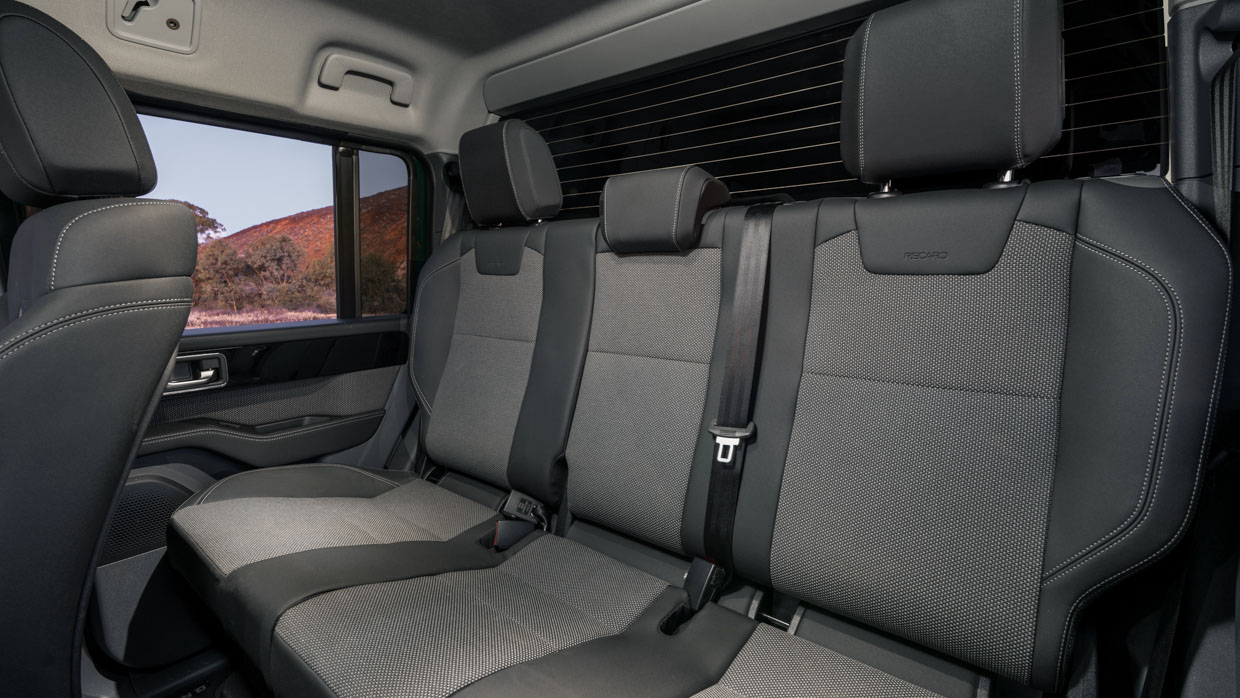
Also raising an eyebrow is the shortage of rear legroom for dual-cab stretching to nearly 5.5 metres.
The front seats – by the now sadly departed Recaro – are terrific, however, at least in the Fieldmaster edition we spent all our time in.
Like a classic Defender 110, the Grenadier has been engineered to thrive in the country rather than the city.
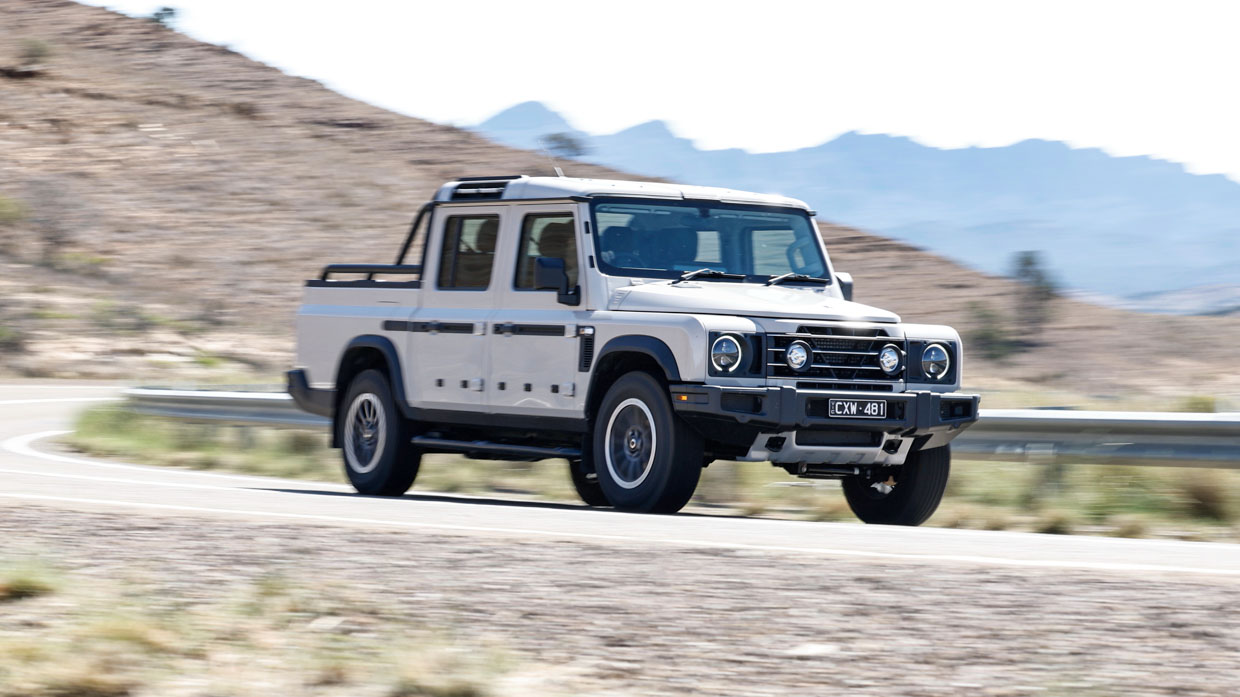
The recirculating-ball steering is at the heart of the compromised on-road experience. Old-fashioned and shared by very few vehicles – such as the Jeep Wrangler/Gladiator and Suzuki Jimny – while virtually every other car these days is rack and pinion, the Ineos’s steering is slow and lacks self-centreing.
The ute’s turning circle is a woeful 14.5 metres – that’s a full metre wider than that of the wagon.
Remarkable vagueness means the driver is regularly moving the steering wheel even when travelling in a straight line, as if there’s phantom gravel beneath the wheels rather than grippy bitumen.
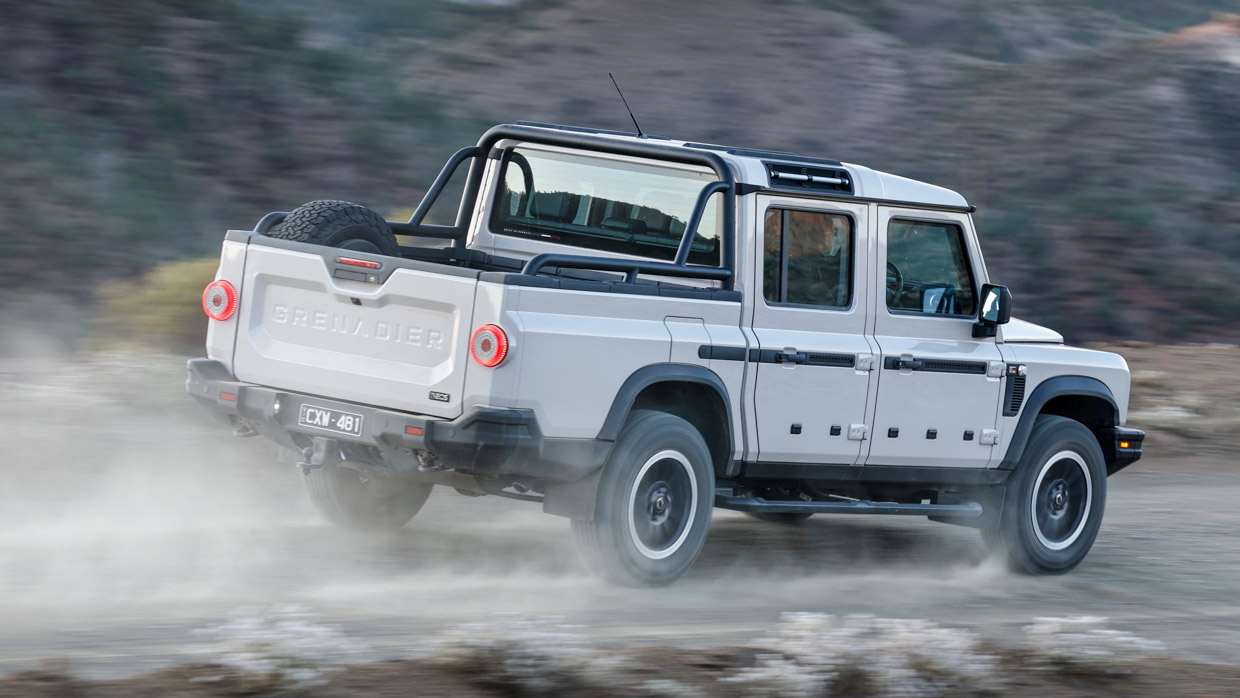
Although the rear suspension has coil springs, the Quartermaster’s ride – at least in the case of the 18-inch-wheeled Fieldmaster model we drove – has similar characteristics to most leaf-sprung dual-cabs – on the stiff side, and jiggly over rougher surfaces.
The unladen ride is resistant to bouncing, however, and with excellent Brembo brakes and stability through corners despite the expected body roll, it’s possible to feel confident pedalling the Quartermaster along a quick country road despite the flawed steering.
The steering feels much more natural off road – as does the ute overall – and the benefits are a steering wheel that remains relatively calm in the driver’s hands, free of shakes or kickbacks as the Quartermaster traverses rough surfaces including corrugated tracks.
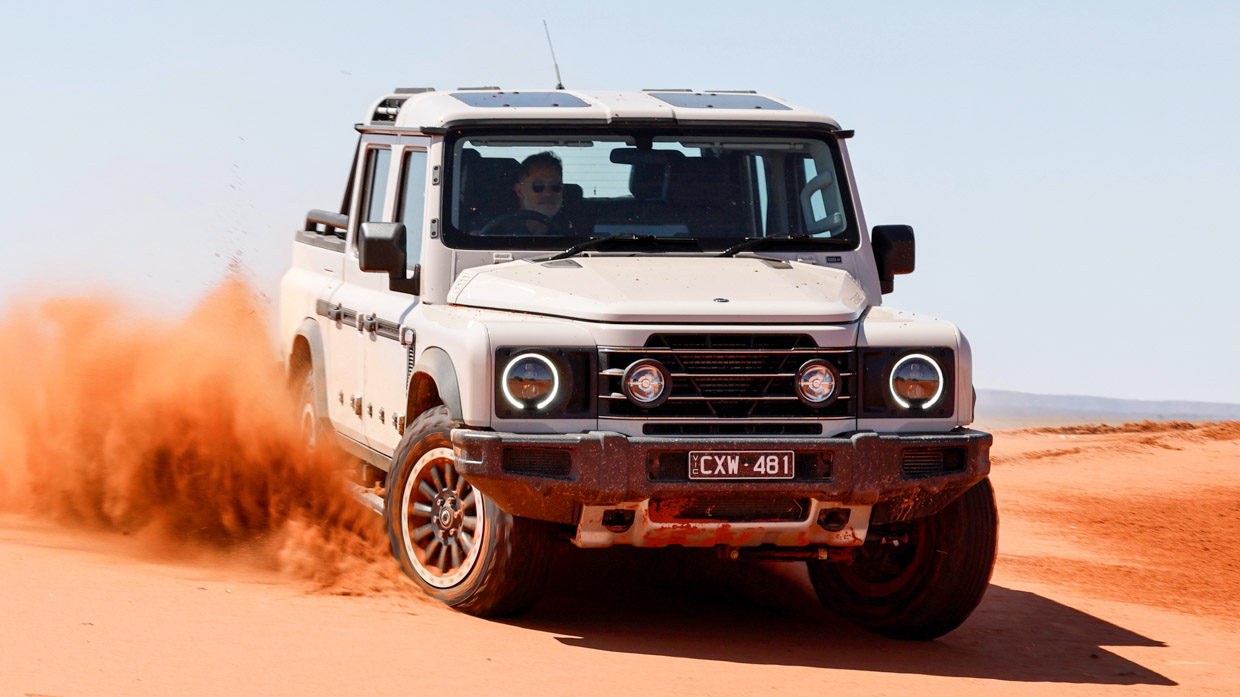
There were surprisingly few hard-core 4×4 challenges during the Flinders Ranges launch, with 4 High more than sufficient for the vast majority of the driving challenges during our trip.
Low range – with the standard centre diff locked – was employed mainly for some brief playtime in some deep, soft sand. (The Ineos team also told us to use the rear diff lock for a run up a modestly sized dune, yet it was probably not required.)
The Quartermaster certainly feels equipped for tougher challenges, even if its longer wheelbase and significant rear overhang give it inferior ramp-over and departure angles to the wagon: 26.2 versus 28.2 degrees and 26.2 versus 36.1 degrees, respectively.
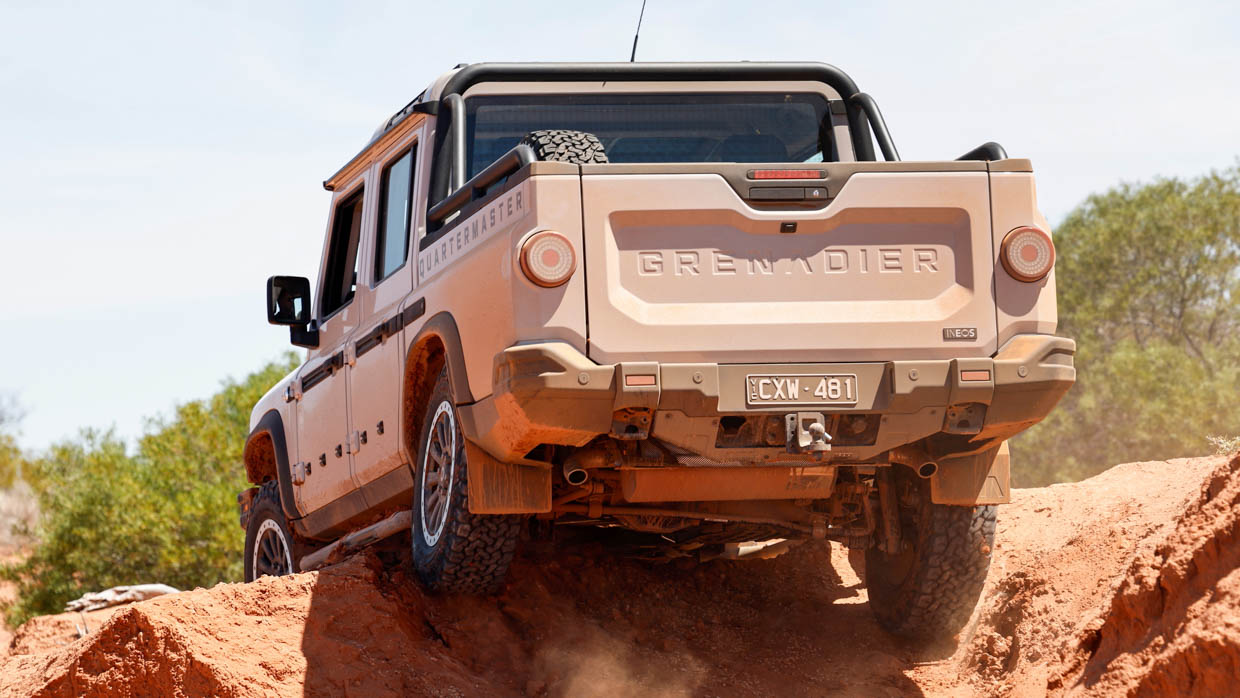
There’s 264mm of ground clearance, up to three locking differentials, that dual-range transfer case, 800mm wading capability with or without a snorkel (optional on base and Fieldmaster versions), and Ineos says there is 585mm of wheel travel.
Another option on our vehicle was a set of BF Goodrich T/A KO2 3m tyres (over regular BF Goodrich all-terrain rubber).
Going off road in the Ineos is just a bit more complex than it is in something like the (modern) Land Rover Defender, with its Terrain Response system that will tailor the vehicle’s settings for varying terrain by the simple turn of a rotary dial.
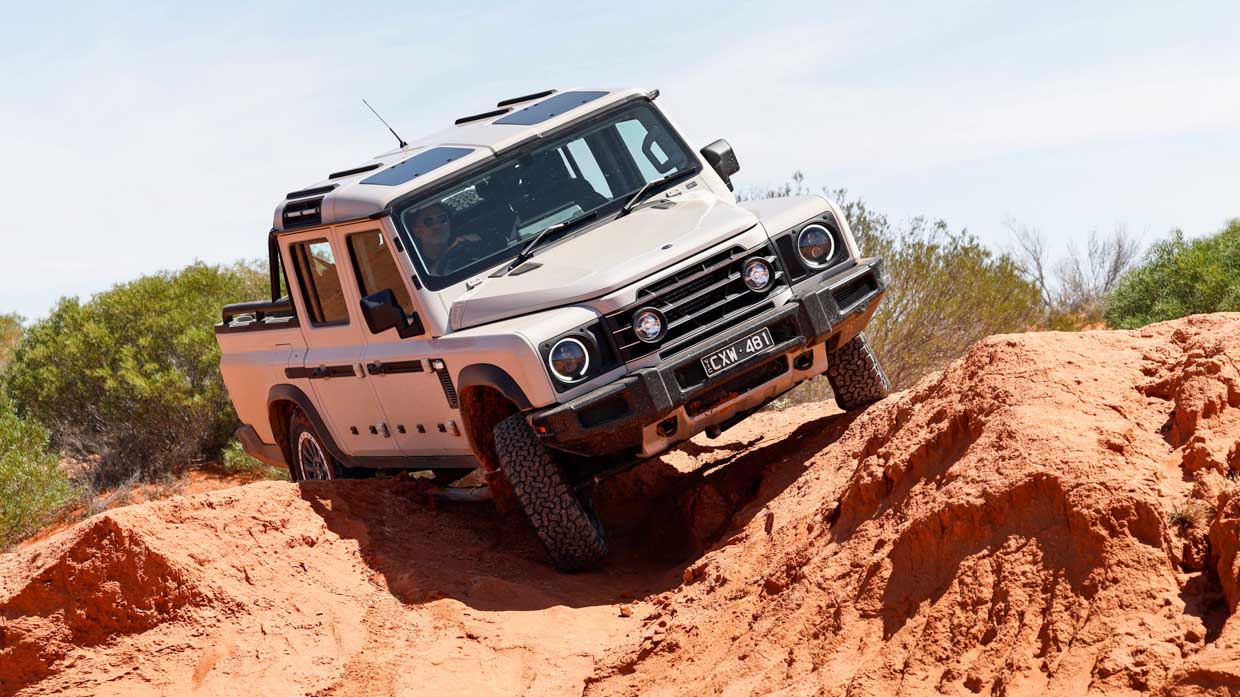
The dual-range lever needs a little bit of muscle to shift it across from variable four-wheel drive to Low or High range with the centre diff locked.
There are also particular processes for engaging (and disengaging) the Off-Road mode and front and rear diff locks. The handbrake needs to be applied for engaging Off-Road, for example, a mode that simply turns off seatbelt reminders and parking sensors. Some buttons require a double tap, some require one press followed by a delayed second press.
My co-driver had seemingly followed the correct procedure for disengaging the rear diff lock at one point, only for it to try reconnecting to the bemusement of even the launch support team.
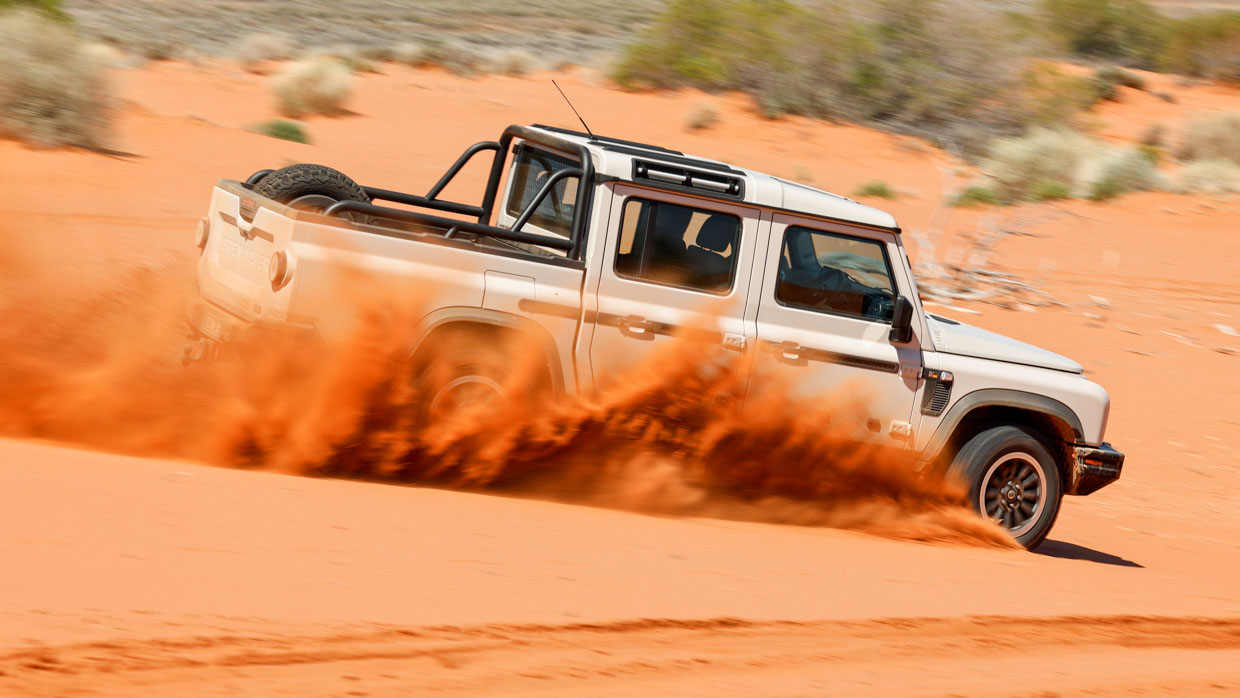
After about 10 minutes of steering wheel wriggling in forwards and reverse, and a couple of engine switch offs and on, the differential decided to go back in its box, as it were.
The Quartermaster’s BMW twin-turbo six-cylinder diesel is a peach, regardless of where you’re driving.
Refinement is a word rarely used to describe an engine in an off-road vehicle, but the 3.0-litre diesel sounds civilised (though purposeful when worked), revs smoothly, and offers a meaty 550Nm exactly where you want it, in the low to mid engine range (1250-3000rpm).
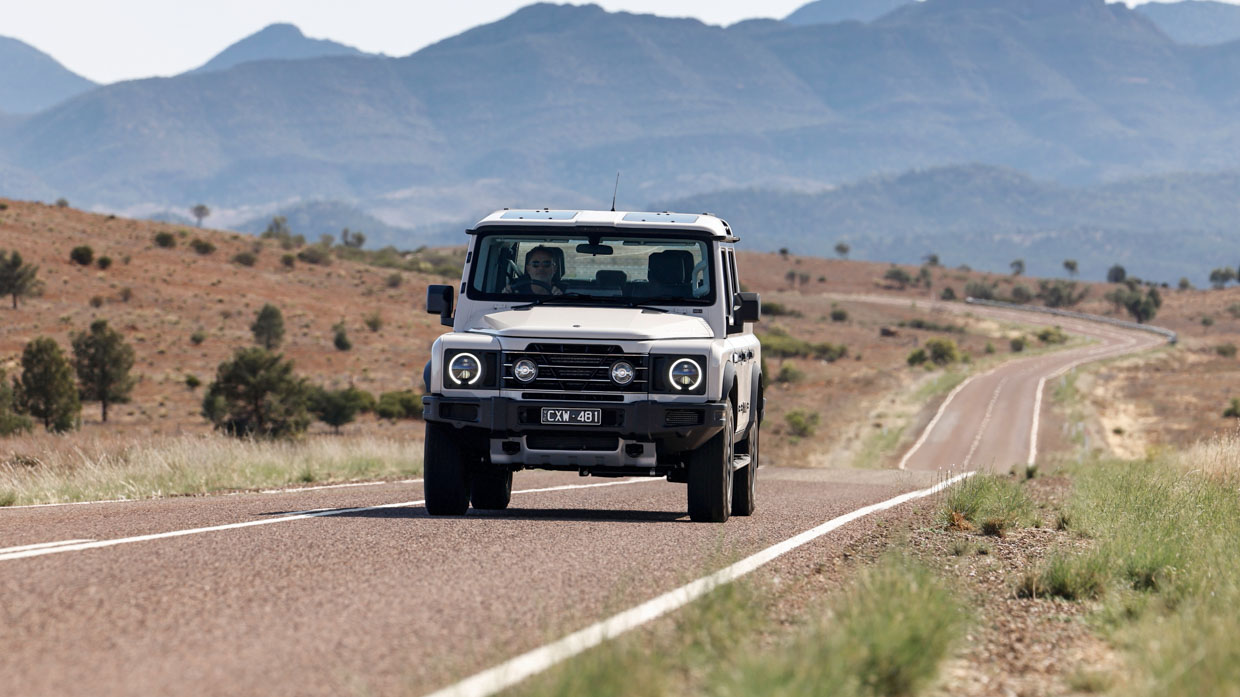
Officially, fuel usage is rated between 10.9 and 12.1 litres per 100km; our trip computer indicated a low of 11.7 and a high of 13.3L/100km during our trip.
A petrol 3.0-litre single-turbo straight-six is an intriguing alternative, set to account for about one in five Quartermaster sales according to Ineos.
Predictably, the 210kW/450Nm engine – which we unfortunately didn’t get to sample – is less economical than the 183kW diesel (14.4-14.9L/100km). But the petrol option will cover the 0-100km/h sprint in a claimed 8.6 seconds, or a significant 1.3 seconds quicker than the diesel.
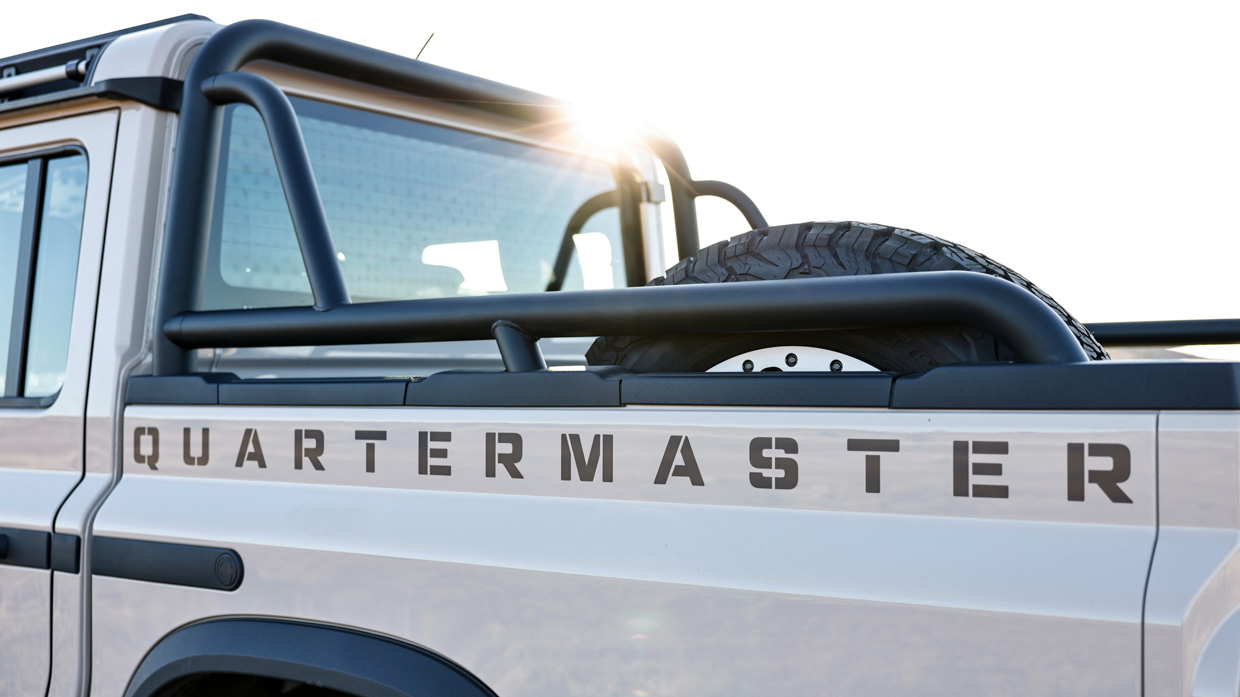
Ineos knows the six-cylinder engines, especially the diesel, are one of the Quartermaster’s strongest drawcards, and they were indeed noted by some 4WD locals when we conducted some casual vox-pops at the Prairie Hotel in Parachilna.
They form part of a niche package that’s not short on character and looks the part. But it’s also very different in price to segment rivals – expensive, even if you don’t need to be a billionaire to afford one.
Key specs (as tested)
About Chasing cars
Chasing Cars reviews are 100% independent.
Because we are powered by Budget Direct Insurance, we don’t receive advertising or sales revenue from car manufacturers.
We’re truly independent – giving you Australia’s best car reviews.
The estimate provided does not take into account your personal circumstances but is intended to give a general indication of the cost of insurance, in order to obtain a complete quote, please visit www.budgetdirect.com.au. Estimate includes 15%^ online discount.
^Conditions Apply
Budget Direct Insurance arranged by Auto & General Services Pty Ltd ACN 003 617 909(AGS) AFSL 241 411, for and on behalf of the insurer, Auto & General Insurance Company Limited(ABN 42 111 586 353, AFSL 285 571).Because we don’t know your financial needs, we can’t advise you if this insurance will suit you. You should consider your needs and the Product Disclosure Statement before making a decision to buy insurance. Terms and conditions apply.
Indicative quote based on assumptions including postcode , 40 year old male with no offences, licence suspensions or claims in the last 5 years, a NCD Rating 1 and no younger drivers listed. White car, driven up to 10,000kms a year, unfinanced, with no modifications, factory options and/or non-standard accessories, private use only and garaged at night.
^Online Discounts Terms & Conditions
1. Discounts apply to the premium paid for a new Budget Direct Gold Comprehensive Car Insurance, Third Party Property Only or Third Party Property, Fire & Theft Insurance policy initiated online on or after 29 March 2017. Discounts do not apply to optional Roadside Assistance.
2. Discounts do not apply to any renewal offer of insurance.
3. Discounts only apply to the insurance portion of the premium. Discounts are applied before government charges, taxes, levies and fees, including instalment processing fees (as applicable). The full extent of discounts may therefore be impacted.
4. We reserve the right to change the offer without notice.